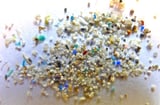Groundbreaking Study Finds Microplastics in Human Brain Tissue, Raising Health Concerns and Calls for Global Action
September 18, 2024
The study, published in JAMA Network Open, involved analyzing olfactory bulb samples from 15 cadavers aged between 33 and 100 years, revealing microplastics in eight of the samples.
A total of 16 plastic fibers and particles were identified, measuring between 5.5 and 26.4 micrometers, with polypropylene being the most prevalent type detected.
Recent research has made a groundbreaking discovery of microplastics in human brain tissue, specifically within the olfactory bulb, marking the first documentation of such findings.
Researchers suggest that the olfactory pathway may serve as a significant entry point for microplastics into the brain, raising concerns about indoor air pollution.
The findings indicate that nasal tissue could capture plastic fragments, contributing to the presence of microplastics in the brain.
Concerns have been raised about the potential for microplastics to alter cellular functions, particularly in vulnerable populations such as children.
In related research, a study on mice exposed to polystyrene microplastics under high-fat diet conditions showed significant changes in gut microbiota and glucose metabolism disorders.
These findings underscore the health risks posed by microplastic exposure, particularly for individuals consuming high-fat diets.
Global scientists and campaigners are calling for urgent action regarding the health impacts of plastics, advocating for a comprehensive UN Global Plastics Treaty.
A final round of negotiations for this treaty is set to occur in November in South Korea, where stronger health provisions will be demanded.
Maria Westerbos, founder of the Plastic Soup Foundation, has criticized policymakers for yielding to petrochemical companies and emphasizes the need for immediate action based on scientific findings.
Overall, these studies highlight the pervasive nature of microplastics in the environment and their potential implications for human health.
Summary based on 6 sources
Get a daily email with more Science stories
Sources

Euronews • Sep 17, 2024
Microplastics can be breathed into your brain, new study shows
Smithsonian Magazine • Sep 18, 2024
Scientists Find Microplastics in Human Brain Tissue Above the Nose
ScienceAlert • Sep 19, 2024
New Study Detects Microplastics in Human Brain Tissue
Slashdot • Sep 17, 2024
New Research Finds Microplastics In the Brain's Olfactory Bulb - Slashdot